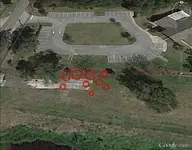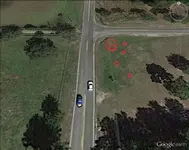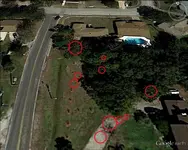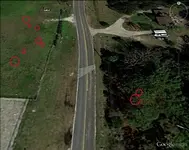You are using an out of date browser. It may not display this or other websites correctly.
You should upgrade or use an alternative browser.
You should upgrade or use an alternative browser.
Dowsing
- Thread starter chancey55
- Start date
aarthrj3811
Gold Member
- Joined
- Apr 1, 2004
- Messages
- 9,256
- Reaction score
- 1,176
- Golden Thread
- 0
- Location
- Northern Nevada
- Detector(s) used
- Dowsing Rods and a Ranger Tell Examiner
No gold, silver or gem stones
Red_desert
Gold Member
- Joined
- Feb 21, 2008
- Messages
- 7,154
- Reaction score
- 3,790
- Golden Thread
- 0
- Location
- Midwest USA
- Detector(s) used
- Garrett Ace 250/GTA 1,000; Fisher Gold Bug-2; Gemini-3; Unique Design L-Rods
- Primary Interest:
- All Treasure Hunting
Red_desert
Gold Member
- Joined
- Feb 21, 2008
- Messages
- 7,154
- Reaction score
- 3,790
- Golden Thread
- 0
- Location
- Midwest USA
- Detector(s) used
- Garrett Ace 250/GTA 1,000; Fisher Gold Bug-2; Gemini-3; Unique Design L-Rods
- Primary Interest:
- All Treasure Hunting
Real de Tayopa Tropical Tramp
Gold Member
- Joined
- Nov 8, 2004
- Messages
- 14,582
- Reaction score
- 11,947
- Golden Thread
- 0
- Location
- Alamos,Sonora,Mexico
- Primary Interest:
- All Treasure Hunting
l
Ladies & gentlemen - if dowsers qualify as gentlemen--here is an hour long video which 0bliquely covers the fields on the human psyche that could be asssiuated with dowsing. is very interesting.
Ladies & gentlemen - if dowsers qualify as gentlemen--here is an hour long video which 0bliquely covers the fields on the human psyche that could be asssiuated with dowsing. is very interesting.
dog the treasure hunter
Gold Member
- Joined
- Jan 16, 2011
- Messages
- 5,010
- Reaction score
- 5,039
- Golden Thread
- 0
- Location
- By, By Have fun.
- Detector(s) used
- Time to move on. Good luck everyone .
- Primary Interest:
- All Treasure Hunting



 Waiting for the show.
Waiting for the show.Real de Tayopa Tropical Tramp
Gold Member
- Joined
- Nov 8, 2004
- Messages
- 14,582
- Reaction score
- 11,947
- Golden Thread
- 0
- Location
- Alamos,Sonora,Mexico
- Primary Interest:
- All Treasure Hunting
Someone stole it sniff, but as a sub here is one on Hieronymus. He was one of my mentors.
it is a bit long but it shows that a mere drawing will work, in other words no elaborate incantations or devices are needed.,
just getout and successfully dowse.
16) T. Galen Hieronymus | DRAGONLINE STUDIO
it is a bit long but it shows that a mere drawing will work, in other words no elaborate incantations or devices are needed.,
just getout and successfully dowse.
16) T. Galen Hieronymus | DRAGONLINE STUDIO
Real de Tayopa Tropical Tramp
Gold Member
- Joined
- Nov 8, 2004
- Messages
- 14,582
- Reaction score
- 11,947
- Golden Thread
- 0
- Location
- Alamos,Sonora,Mexico
- Primary Interest:
- All Treasure Hunting
Ransomed it dog. -----
Red_desert
Gold Member
- Joined
- Feb 21, 2008
- Messages
- 7,154
- Reaction score
- 3,790
- Golden Thread
- 0
- Location
- Midwest USA
- Detector(s) used
- Garrett Ace 250/GTA 1,000; Fisher Gold Bug-2; Gemini-3; Unique Design L-Rods
- Primary Interest:
- All Treasure Hunting
Anduril
Bronze Member
- Joined
- Aug 31, 2015
- Messages
- 1,239
- Reaction score
- 1,602
- Golden Thread
- 0
- Location
- South Florida
- Detector(s) used
- Garrett GTI-2500
- Primary Interest:
- Metal Detecting
Check the red circles.
I'd too would be curious to know what is found via dowsing.
In May 2010, the area just south of the IEC (built in 2008) was used for storage of municpial waste-water drainage pipes.
See image below.
The water treatment plant just north across the street is long gone - maybe 10 years now(?)
Most of the remaining development has only been since 1980-85
Prior to that, appears to be just vacant unimproved land.

dog the treasure hunter
Gold Member
- Joined
- Jan 16, 2011
- Messages
- 5,010
- Reaction score
- 5,039
- Golden Thread
- 0
- Location
- By, By Have fun.
- Detector(s) used
- Time to move on. Good luck everyone .
- Primary Interest:
- All Treasure Hunting
Ransomed it dog. -----
That was very interesting Real TTT,thanks. One thing i picked up was if i really hydrate myself with electrolytes,Gatorade and what not before i go dowsing,it should help the signal. Thanks again.
Anduril
Bronze Member
- Joined
- Aug 31, 2015
- Messages
- 1,239
- Reaction score
- 1,602
- Golden Thread
- 0
- Location
- South Florida
- Detector(s) used
- Garrett GTI-2500
- Primary Interest:
- Metal Detecting
FWIW: This guy doesn't seem to have a clue what he's talking about.
The presentation is littered with inaccuracies.
I realize he is a mechanical engineer, and not an electrical engineer specializing in wireless technologies.
I also realize that he's probably talking to a mostly lay audience.
I'll just give you a taste for now, but if I get time to watch the whole thing later this week, maybe I can provide the play-by-play.
But for now, here are a couple of real howlers:
@ 13:02, he's describing the range of cell phones as "2, 3 or 4 miles". Um, try 35 miles (maximum), and that's still at only about 180mW or so handset output power.
True, it does depend on the network and the technology (GSM, UMTS, LTE, etc..) and of course, frequency re-use (network planning, etc..)
There are timing advances and propagation delays BUILT-IN to the signaling and THIS is what really limits the range, in addition to power, radio line-of-sight, etc..
A modern cellular network (in rural or offshore areas, given re-use considerations) can easily hang-on to your call, with acceptable quality, down to about -110 to -120 dBm. That's easily 20 miles in a reasonably quiet environment. In big cities, this number is often about 10dB unrealistic, but it's still a very tiny amount of signal needed to complete the call.
There are also multiple problems encountered when trying to compare Wi-Fi output power to cellular/PCS power (at either the base station or the handset).
The modulation schemes are completely different and simply cannot be measured or compared in the same way.
Also, for the newer LTE formats, the uplink and downlink modulation schemes (and hence, the watts per Hertz power bandwidths) are also completely different from each other.
It's like comparing apples to donkeys. (You can do it, but why would you want to?)
@13:30, another howler.
The notion that Wi-Fi range depends on power.
Sorry to disappoint, in the US and most other industrialized nations, maximum Wi-Fi output power is limited by law (and it's pretty low, actually).
In his "industrial setting" example, you wouldn't want high power anyway!
Network capacity is the true constraint.
You are much better off with lots and lots of little low-power nodes (i.e., access points) than you are with a single centralized "high power" Wi-Fi access point.
You can get "orders of magnitude" more throughput by using LOWER POWER nodes, than compared to trying to use a single, high-power, bandwidth-limited channel arrangement. You simply can't do it with high power - it is not possible. He's just totally wrong on this.
I have a feeling I know where this guy might be going, but I should view the rest of the video first.
I had to stop watching when the speaker started to compare the SAR's of various cellular handsets.
Let's table the discussion about Specific Absorption Rates, and what they really mean, for now.
The fact is, your handset's output power is controlled by the cellular network, not by the phone. (So, why compare the phones? - Compare the NETWORKS!) Phone-x may have the CAPABILITY to output (slightly) more power than Phone-y, but in real-world use, neither one of them even come close to their maximum capabilities. The phone that, on average, will "have" the highest SAR will be the one that has to power up the most to reach the network towers. Typically, that means the carriers who have the fewest towers constructed in your service area.
How do you think that cell phone battery lasts so long? (I can assure it's not by pumping out a lot of RF power!!)
The presentation is littered with inaccuracies.
I realize he is a mechanical engineer, and not an electrical engineer specializing in wireless technologies.
I also realize that he's probably talking to a mostly lay audience.
I'll just give you a taste for now, but if I get time to watch the whole thing later this week, maybe I can provide the play-by-play.
But for now, here are a couple of real howlers:
@ 13:02, he's describing the range of cell phones as "2, 3 or 4 miles". Um, try 35 miles (maximum), and that's still at only about 180mW or so handset output power.
True, it does depend on the network and the technology (GSM, UMTS, LTE, etc..) and of course, frequency re-use (network planning, etc..)
There are timing advances and propagation delays BUILT-IN to the signaling and THIS is what really limits the range, in addition to power, radio line-of-sight, etc..
A modern cellular network (in rural or offshore areas, given re-use considerations) can easily hang-on to your call, with acceptable quality, down to about -110 to -120 dBm. That's easily 20 miles in a reasonably quiet environment. In big cities, this number is often about 10dB unrealistic, but it's still a very tiny amount of signal needed to complete the call.
There are also multiple problems encountered when trying to compare Wi-Fi output power to cellular/PCS power (at either the base station or the handset).
The modulation schemes are completely different and simply cannot be measured or compared in the same way.
Also, for the newer LTE formats, the uplink and downlink modulation schemes (and hence, the watts per Hertz power bandwidths) are also completely different from each other.
It's like comparing apples to donkeys. (You can do it, but why would you want to?)
@13:30, another howler.
The notion that Wi-Fi range depends on power.
Sorry to disappoint, in the US and most other industrialized nations, maximum Wi-Fi output power is limited by law (and it's pretty low, actually).
In his "industrial setting" example, you wouldn't want high power anyway!
Network capacity is the true constraint.
You are much better off with lots and lots of little low-power nodes (i.e., access points) than you are with a single centralized "high power" Wi-Fi access point.
You can get "orders of magnitude" more throughput by using LOWER POWER nodes, than compared to trying to use a single, high-power, bandwidth-limited channel arrangement. You simply can't do it with high power - it is not possible. He's just totally wrong on this.
I have a feeling I know where this guy might be going, but I should view the rest of the video first.
I had to stop watching when the speaker started to compare the SAR's of various cellular handsets.
Let's table the discussion about Specific Absorption Rates, and what they really mean, for now.
The fact is, your handset's output power is controlled by the cellular network, not by the phone. (So, why compare the phones? - Compare the NETWORKS!) Phone-x may have the CAPABILITY to output (slightly) more power than Phone-y, but in real-world use, neither one of them even come close to their maximum capabilities. The phone that, on average, will "have" the highest SAR will be the one that has to power up the most to reach the network towers. Typically, that means the carriers who have the fewest towers constructed in your service area.
How do you think that cell phone battery lasts so long? (I can assure it's not by pumping out a lot of RF power!!)
Real de Tayopa Tropical Tramp
Gold Member
- Joined
- Nov 8, 2004
- Messages
- 14,582
- Reaction score
- 11,947
- Golden Thread
- 0
- Location
- Alamos,Sonora,Mexico
- Primary Interest:
- All Treasure Hunting
anduni, y9ou posted --- The fact is, your handset's output power is controlled by the cellular network, not by the phone. (So, why compare the phones? - Compare the NETWORKS!) Phone-x may have the CAPABILITY to output (slightly) more power than Phone-y, but in real-world use, neither one of them even come close to their maximum capabilities. The phone that, on average, will "have" the highest SAR will be the one that has to power up the most to reach the network towers. Typically, that means the carriers who have the fewest towers constructed in your service area.
Clarify please.
Clarify please.
Anduril
Bronze Member
- Joined
- Aug 31, 2015
- Messages
- 1,239
- Reaction score
- 1,602
- Golden Thread
- 0
- Location
- South Florida
- Detector(s) used
- Garrett GTI-2500
- Primary Interest:
- Metal Detecting
anduni, y9ou posted --- The fact is, your handset's output power is controlled by the cellular network, not by the phone. (So, why compare the phones? - Compare the NETWORKS!) Phone-x may have the CAPABILITY to output (slightly) more power than Phone-y, but in real-world use, neither one of them even come close to their maximum capabilities. The phone that, on average, will "have" the highest SAR will be the one that has to power up the most to reach the network towers. Typically, that means the carriers who have the fewest towers constructed in your service area.
Clarify please.
Hello there,
Admittedly, not terribly familar with Mexico states, but hope that you and your family survived the recent Hurricane Patricia just fine!!
From the news, looks like the impacts were not as bad as many feared.
As to your question - I can read this two ways, so let me try to answer both:
1) HOW the cell phone output power is controlled:
I did some quick searching online and found this link (maybe not the best?), but of the few I looked at, seems to be "understandable" by non-engineers.
The Inner Loop uplink power control discussion starts on Slide-10.
You just need to know that "UE" = "User Equipment" (in other words, a cell phone handset).
http://www.comlab.hut.fi/opetus/333/reports/Yin_Power_control_in_cellular_systems.pdf
Also, there are a few different power control schemes going on, but the one we're interested in in the "Inner Loop Power Control" because this is the one that is active the VAST majority of the time. There is a separate scheme for INITIAL network access, and even this is power-control limited - but it's a little more autonomous than the inner loop. Not by much, and, it's only active for those first few seconds when you turn the phone on, and maybe when switching to roaming if you leave your network. The third control is the "Outer Loop", and this deals with balancing the whole network, and doesn't have the same effect on your handset's output power. Think of it as the slow trending, or "course tune" power control for the whole system. The handset output power is controlled via networks commands sent to the handset 1500 times a second (for UMTS 3G networks).
2) The other way to read your question is: What does carrier tower density have to do with it?
Typically, fewer towers mean the towers are spaced further apart to cover a given geographic area. Underlying this is population density, because the more traffic demand there is, the more towers you will need to service the traffic at reasonable speed and quality - there's only so much spectrum, you have to re-use it (either via codes, or discrete channels).
Anyway -- the further the towers are apart, the more likely you're going to more distant to them.
Keep in mind, your phone is sometimes connecting to more than one tower at a time. (That's too complicated to get into here - but it explains the need for Outer Loop power control.)
Another consideration is actual frequency. Here in the US, "Cellular" is in the 850 MHz band (Uplink = handset-to-tower: 824 to 849 MHz), and (Downlink = tower-to-handset) is 45 MHz above that. For PCS, it's UL: 1850-1910, with DL 80 MHz higher. There are other bands with different frequency splits.
The point is, the higher frequencies don't propagate as well as the lower ones do -- particularly for in-building coverage.
In the US, for "most" markets, Verizon and AT&T have the majority of the lower spectrum. The other (smaller) carriers tend to have the higher channels. That's not to say that Verizon and AT&T don't have higher channels too. They do. But Verizon and AT&T have huge market share, therefore the most customers, therefore the most towers, therefore the highest tower density - and - therefore, on average, the least need for high handset power in the uplink to reach those towers.
So, to recap: Your handset output power (uplink: handset-to-tower) is controlled by the network.
For the 2nd, or 3rd tier network provider, the "network" is typically more distant from you, and typically using "non-optimal" high frequencies, which causes your phone to transmit more power, on average, over time.
In the case of a 1st tier provider (Verizon and AT&T here in the US), the towers, on average, are closer and using frequencies that propagate better -- meaning that your handset can put out less power, on average, over time, as it communicates with those networks. And even when on the "less than ideal" higher frequencies used by these 1st tier carriers, they still tend to have more towers (which means they are statistically closer to you) so your handset still doesn't need to talk as far, and thereby uses less power as determined by the inner power control loop. BUT - these networks can be more crowded, and cost more. So, they're not necessarily ideal for every user.
This is a big-picture discussion.
There are places, even here in the US, where Verizon and AT&T are NOT the 1st tier carriers.
Doesn't really matter who is as far as the inner-loop power control goes, however.
Tower density is usually a function of traffic demand, which goes hand-in-hand with population density.
Your handset is going to transmit the most power when it is far from the nearest tower (network) resource in terms of downlink signal strength from that tower.
Could be 20 miles away or more.
Note also that the higher frequencies are not absorbed by the human body as well as the lower frequencies are, so you have to factor this in as well.
It turns out the FM Broadcast Band (i.e., 88-108 MHz) has the best absorption by humans because those wavelengths are close to the resonant length of adult human beings.
The wavelenghts for Wi-Fi, cellular, PCS, AWS, and LTE (above 700 MHz) are all a small fraction by comparison, not resonant, and not nearly so well absorbed.
Did this help, or did I just confuse the heck out of you!?

Last edited:
Real de Tayopa Tropical Tramp
Gold Member
- Joined
- Nov 8, 2004
- Messages
- 14,582
- Reaction score
- 11,947
- Golden Thread
- 0
- Location
- Alamos,Sonora,Mexico
- Primary Interest:
- All Treasure Hunting
Gracias Anduni. To answer your question , 'no', a year of military Electronic schooling and some television . radio work makes it quite understandable, it does not confuse me. What I did not understand originally is that it is a feed back for the cell phone to control its output power by the tower up to it's max allowable CP output power.
So the study does not take into account cell phone out put between city usage and county usage.
However any rf out put does some harm.


 or if you prefer
or if you prefer 
So the study does not take into account cell phone out put between city usage and county usage.
However any rf out put does some harm.


 or if you prefer
or if you prefer 
Last edited:
Red_desert
Gold Member
- Joined
- Feb 21, 2008
- Messages
- 7,154
- Reaction score
- 3,790
- Golden Thread
- 0
- Location
- Midwest USA
- Detector(s) used
- Garrett Ace 250/GTA 1,000; Fisher Gold Bug-2; Gemini-3; Unique Design L-Rods
- Primary Interest:
- All Treasure Hunting
Thanks Tommy!Hi Red_desert
Thanks a lot for your time.Iwill let you know what I find.
Thank you so much
chancey55 Tommy
Similar threads
Users who are viewing this thread
Total: 1 (members: 0, guests: 1)
















